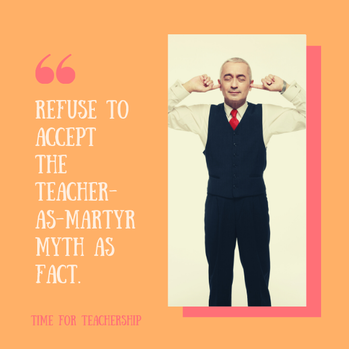|
Teachers, do you believe your only choice is between running yourself into the ground or completely failing your students? I used to be you! Then, I realized these 2 things are not mutually exclusive—you could run yourself into the ground AND fail your students. Also, fortunately, the opposite can be true! You can have a rich and fulfilling life outside of school. At the same time you’re bringing home less work and giving yourself more free time to recharge, your students can actually learn more. In fact, they may learn because of your decision to spend less time on work. How is it possible you spending less time on work could help your students learn more? Having a martyrdom mindset leads to burnout, and research indicates teacher burnout negatively impacts student learning. That’s right. Your choice to work non-stop to serve your students might be having the opposite effect. Studies show 78% of teachers feel exhausted at the end of the day - both physically and emotionally. The impacts of this exhaustion include increased illness, absenteeism, cynicism, and poor decision making as well as decreased energy and enjoyment. As you might imagine, this does not bode well for student learning. Teacher burnout predicts student academic outcomes and is correlated with lower levels of student motivation and increased student stress (Lever, Mathis, & Mayworm, 2017). In fact, the most general influence on a student’s emotional engagement is a positive teacher demeanor, meaning their enthusiasm for learning and their ability to make students feel welcome, accepted, and supported. Bringing excitement into the classroom and taking the time to personally connect with students requires that we, as teachers, come to school rested and ready to go (Marzano, Pickering & Heflebower, 2010) . How do we overcome the teacher-as-martyr myth? Refuse to accept it as fact. I wrote this blog post for the sole purpose of helping you shift your mindset around this myth of martyrdom. You don’t need to take any action other than spending some type unlearning this idea. However, if that response does not satisfy you because you are an action-taker looking for something to do, I suggest you take one small step and test the concept. Step back and ask yourself: How can I work smarter, not harder? What can I cut or transform so that students are taking more ownership of their learning and I’m bringing less work home? If you need some ideas to get you started, check out my Hand off the Heavy Lifting post from last week. If you want even more ideas, save a seat in my FREE 1-hour live masterclass: How to Save Time Grading and Lesson Planning Without Sacrificing Student Learning. If you’re reading this after my free masterclass has ended or you want the details and specific strategies behind the shifts I discuss in the 1 hour class, I’ve got you covered. Enrollment for my Work Less Teach More course opens TODAY and will stay open until March 24, 2020. See you there, rockstar teachers.
0 Comments
Leave a Reply. |
Details
For transcripts of episodes (and the option to search for terms in transcripts), click here!
Time for Teachership is now a proud member of the...AuthorLindsay Lyons (she/her) is an educational justice coach who works with teachers and school leaders to inspire educational innovation for racial and gender justice, design curricula grounded in student voice, and build capacity for shared leadership. Lindsay taught in NYC public schools, holds a PhD in Leadership and Change, and is the founder of the educational blog and podcast, Time for Teachership. Archives
May 2024
Categories |






 RSS Feed
RSS Feed